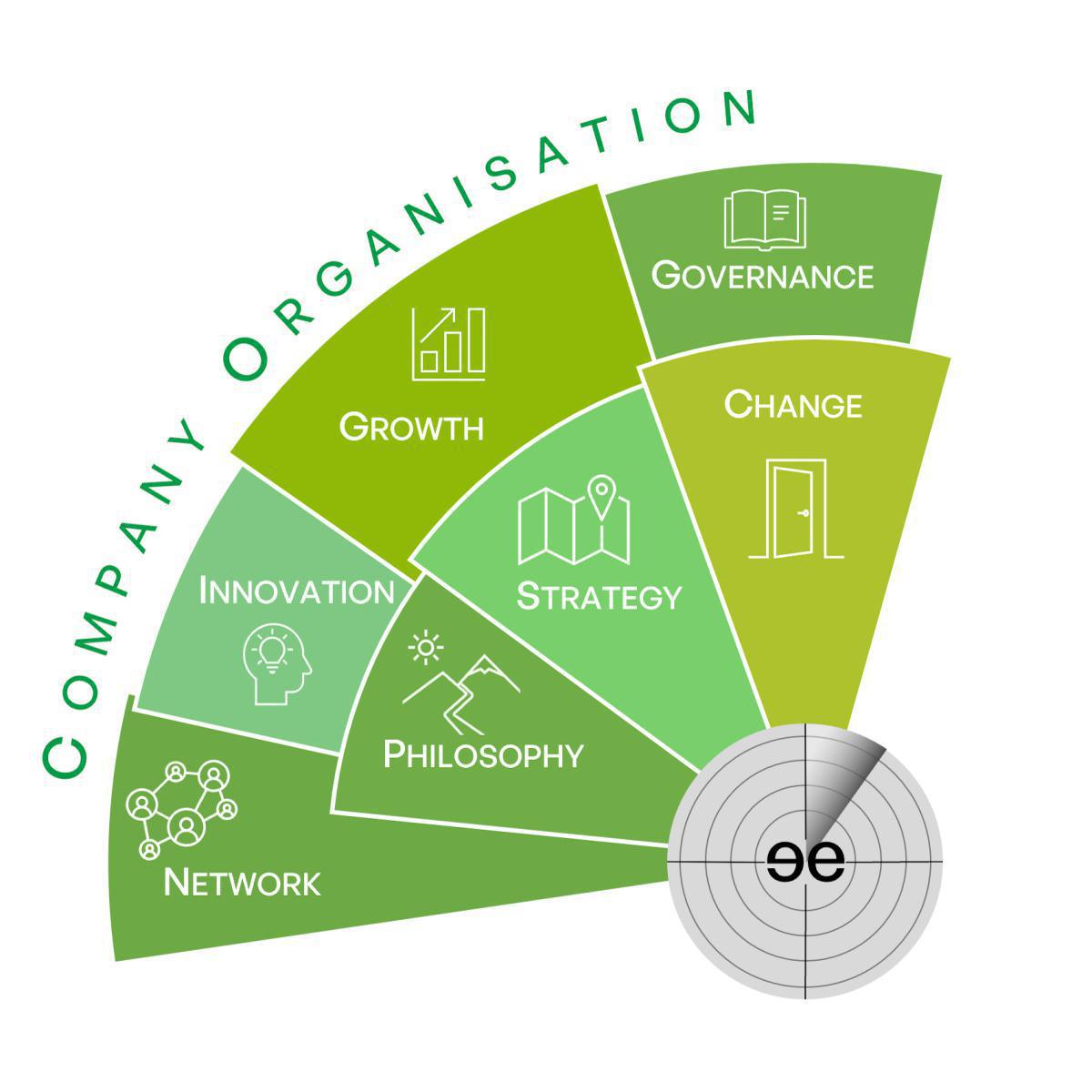4.1 Corporate Organisation
Elements of Enterneering®/Organisation/Company Organisation
| ❮ previous | Table of contents | next ❯ |
The organisation of the company is among the primary tasks for corporate management, alongside the implementation of corporate culture and the further development of itself and the company’s employees. It is important to understand that what is meant here is specifically not the organisation of individual units, projects, processes or customer relationships but the overall functioning of the company as an organism. In companies with multiple management levels, the details therein should always be in direct reporting line to the corporate management or the executive board. This is the point at which, in many companies, the lines of responsibility and action become inconsistent or blurred. The following section will explain why this happens and why it is vital to eliminate specific habitual patterns.
Entrepreneurs who are not able to consciously distinguish between the individual elements and levels of their organisation will find it understandably difficult to determine where they should, or must, devote more of their attention and where they should, or must, delegate. It is clear that not every element or level of the organisation requires the same amount of attention from the entrepreneur. It is also true that not every possible element or level of the corporate organisation should, or can, be equally applied overall. To determine which elements and levels should be applied in a specific situation – and to what extent – entrepreneurs must have a basic familiarity with these elements and be able to categorise them.
A significant phenomenon that often occurs during the organisational or structural work being carried out by a company is that, as the direct involvement of managers and executives in a particular element decreases and the element becomes more generalised or long-term in nature, their interest and commitment to that element decreases. This can be clearly observed, for example, with the element 'strategy'. While initially, nearly all employees involved demonstrate great interest in strategy development, the attention and interest of the majority often wane as the strategy is operationalised and implemented.
One reason for this is the fact that, during implementation, operational and tactical influences, disruptions and distractions repeatedly compete for attention or lead to a non-reflected change of priorities. Why does this happen? Because a specific problem, customer or order is critical right now, and the strategy development, which is targeted at the medium-to-long term, is easier to put off, halt or divert. This is precisely when experienced and consistent management is required to ensure that the strategy (or any other important element) is so firmly anchored within the team and among the executives that its relevance is continuously retained. Management must strike the correct balance between dealing with spontaneously occurring events or requirements and working on long-term goals and must actively demand and exemplify it. For many entrepreneurs, this is an enormous personal challenge that must be consciously mastered.
If nobody, or too few people, with real decision-making power remain involved during the implementation of such essential elements, ensuring they are given sufficient attention and that the work continues, delegation of corporate responsibility quickly becomes invalid or even non-functioning. In the example cited just now, in the worst-case, responsibility for implementing strategy would lie with the Head of Strategy or Head of Development (as the case may be). This person, though technically the responsible and presumably relevant intermediary, coordinator and administrator of the strategy and implementation plan, has no decision-making authority within the individual business units or in executive management.
Along with all the effort involved, the personal interests, strengths and incentives of the individual managers frequently play a role. People who find more enjoyment in a specific business process, an individual project, or their own area of expertise, and find these closer to their interests, are likely to more quickly lose their desire and commitment to a company-wide action. Here too, entrepreneurs and the executive management are called upon to strike a balance and ensure that higher-level goals are achieved.
To approach this topic in an appropriate and honest manner, the following simple rules can be helpful:
| ✓ | Correctly assess the importance of an element. And take your time! Failure to correctly assess yourself, the topic or its importance, and treating it as a side issue, will ultimately lead to your own failure. |
| ✓ | Ensure that you have a basic understanding of the situation. Only if you have understood the various elements and levels involved will you be able to implement them successfully. |
| ✓ | Address a smaller number of elements and levels and give them more attention and consistency. |
| ✓ | The journey is the destination; many elements can be enhanced subsequently and do not have to start off as 'best in class'. |
| ✓ | Consider the culture and maturity level of people with particular responsibility within the company; the best or 'coolest' structural element is of no use if it does not correspond to the maturity of the responsible people or how they think and act. |
| ✓ | Define and adhere to the sequence and priorities among the selected elements; the notorious parallel development of what are essentially important measures quickly leads to stagnation. |
Finally, there is this question: for which companies, and of what complexity or size, is this entire topic relevant, if at all? Or is this question moot because certain elements play a role in every company? There are probably no universal formulas, key figures or benchmarks for this. The most unhelpful answer to this would probably be the legendary 'it depends... ' because, though it may actually be the correct answer, it does not take us any further. What appears to be more useful is a brief self-assessment, in which the most important elements and levels of a company's organisation are documented in terms of their content and immediate significance and compared with the current situation of the company. Ideally, a short gap analysis can be created from this, which would help in developing an understanding and the initial categorisation of relevance and reality.
Elements of company organisation
PHILOSOPHY
Companies need to be able to blend the essential components of the corporate culture with a description of the company's future path and goals. These core elements are key for developing strategy and are important as a central overarching guiding principle for the management of a business, as well as for its long-term alignment.
STRATEGY
Companies need a plan for how, or through what steps, they will achieve their long-term goals. It is essential that these plans be operationalised and converted into roadmaps. The strategy must be both clear to employees and relevant to their work so that they can identify with it as closely as possible.
GROWTH
Growth is at the core of many corporate strategies. The ways in which companies increase their revenue or volume are many and varied. Entrepreneurs need to understand which company-wide conditions are necessary and what is required to ensure that growth leads to the healthy development of the company.
CHANGE
Successful entrepreneurs recognise which business elements need to be maintained and where changes need to be made. They know that change always involves people and organisations. This calls for strategies aimed at effecting and controlling change, as well as helping people adapt to it.
INNOVATION
Innovative capability and innovative strength are important factors for success. Entrepreneurs should know the basics and be aware of what is required to create and maintain an innovative environment and increase innovative strength. They must be able to define appropriate measures and deploy the right people.
NETWORK
Networking involves developing and maintaining contacts that can help a business meet its needs. An important consideration for entrepreneurs is the strengthening of their networks. Being at the right place at the right time, talking to the right people and making the right impression, is key.
GOVERNANCE
Governance is the combination of rules, processes and laws by which businesses are operated, regulated and controlled. It is a commitment to ensure that accountability, diversity, transparency and fairness are upheld in the company. The goal is to enhance business performance while increasing market access.
Related content:
- Elements of Enterneering/Organisation/Philosophy ❭ ❭ ❭
- Elements of Enterneering/Organisation/Strategy ❭ ❭ ❭
- Elements of Enterneering/Organisation/Growth ❭ ❭ ❭
- Elements of Enterneering/Organisation/Change ❭ ❭ ❭
- Elements of Enterneering/Organisation/Innovation ❭ ❭ ❭
- Elements of Enterneering/Organisation/Network ❭ ❭ ❭
- Elements of Enterneering/Organisation/Governance ❭ ❭ ❭


